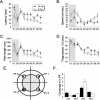Altered hippocampal transcript profile accompanies an age-related spatial memory deficit in mice
- PMID: 15169854
- PMCID: PMC419727
- DOI: 10.1101/lm.68204
Altered hippocampal transcript profile accompanies an age-related spatial memory deficit in mice
Abstract
We have carried out a global survey of age-related changes in mRNA levels in the C57BL/6NIA mouse hippocampus and found a difference in the hippocampal gene expression profile between 2-month-old young mice and 15-month-old middle-aged mice correlated with an age-related cognitive deficit in hippocampal-based explicit memory formation. Middle-aged mice displayed a mild but specific deficit in spatial memory in the Morris water maze. By using Affymetrix GeneChip microarrays, we found a distinct pattern of age-related change, consisting mostly of gene overexpression in the middle-aged mice, suggesting that the induction of negative regulators in the middle-aged hippocampus could be involved in impairment of learning. Interestingly, we report changes in transcript levels for genes that could affect synaptic plasticity. Those changes could be involved in the memory deficits we observed in the 15-month-old mice. In agreement with previous reports, we also found altered expression in genes related to inflammation, protein processing, and oxidative stress.
Figures



References
-
- Amsel, A. 1993. Hippocampal function in the rat: Cognitive mapping or vicarious trial and error? Hippocampus 3: 251-256. - PubMed
-
- Armengou, A. and Davalos, A. 2002. A review of the state of research into the role of Iron in stroke. J. Nutr. Health Aging 6: 136-137. - PubMed
-
- Bach, M.E., Barad, M., Son, H., Zhuo, M., Lu, Y.F., Shih, R., Mansuy, I., Hawkins, R.D., and Kandel, E.R. 1999. Age-related defects in spatial memory are correlated with defects in the late phase of hippocampal long-term potentiation in vitro and are attenuated by drugs that enhance the cAMP signaling pathway. Proc. Natl. Acad. Sci. 96: 5280-5285. - PMC - PubMed
Publication types
MeSH terms
Substances
LinkOut - more resources
Full Text Sources
Other Literature Sources
Medical
Molecular Biology Databases
